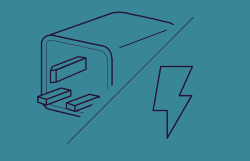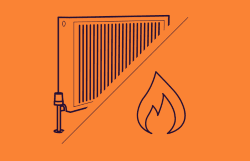CTs – Overview
Current transformers are measuring devices that are used to safely reproduce a low-level current that accurately represents a higher current level. They are mainly used for the purpose of metering (measuring) and protection. They come in numerous different sizes, shapes, and ratings to fit the broad range of applications.
Current transformers are not necessarily permanent installations, with smaller models and styles created especially for ease of use with temporary applications. Permanent installations usually involve slightly larger current transformers and can be found on generators, transformers, and connected loads. Permanent installations are usually required when an individual or business wants to consistently measure the current flowing in a system from a certain point, over an extended period of time.
CTs – How they work
CTs are closed loop instruments consisting of a magnetic core and a secondary winding around that core. The primary lining of the CT has the wire with the current we want to measure passed through the centre of the core.
The primary winding that carries the main current is said to have a single loop for winding. The wire produces the magnetic field that drives the current on the secondary winding which is then used as the output of the current transformer. The current of the secondary winding is proportional to the current flowing through the centre of the core.
An example of this is as follows:
- Take a CT with a rating of 1000 to 5, or turns ratio of 200 to 1.
- 1000 amps flow through the primary circuit (primary winding).
- There is now 5 amps flowing through secondary winding based off of the ratio above.
- We can calculate the third unknown variable if the two others are known from: Ratio, primary circuit current, secondary circuit current.
CTs – Uses in the Energy Industry
As we have established already, current transformers are used mainly for metering and protection. The problem with this, is it still doesn’t lead us any closer to understanding why they are used.
Most households will be fitted with a consumption meter to measure exactly how much gas or electricity is being used over a period of time. Historically, customers would have to manually read the values of this meter and submit them to their energy supplier for billing. Over the last few years smart meters have taken over, negating the need to submit readings and providing more accurate data for billing.
But what happens when an energy supplier isn’t able to meter a supply?
This happens most commonly for business customers demanding huge quantities of energy – it is simply not possible to install one little consumption meter to measure the vast monthly consumption. In order to get around this, current transformers are fitted. This allows for an accurate measurement of consumption – without exposing anybody to unnecessary danger.
CTs – Industry jargon
The energy industry is known for having some ridiculously complex terminology, rife with jargon and interchangeable terms. It makes sense before diving any deeper to familiarise yourself with some of the relevant terms below:
| Acronym | Description | Comment |
| CT | Current Transformer | Current transformers ‘step down’ electrical current to a level that normal-range ammeters can handle. |
| CT Ratio | Current Transformer Ratio | This ratio is crucial for ensuring your meter is programmed correctly. |
| DA | Data Aggregator | Agent responsible for obtaining, managing, and collating data to provide to suppliers for billing. |
| DC | Data Collector | Agent responsible for obtaining, managing, and collating data to provide to suppliers for billing. |
| DR | Data Retriever | Agent responsible for obtaining, managing, and collating data to provide to suppliers for billing. |
| – | Declared Capacity | The capacity for a new electrical supply – measured in kVA. |
| DNO | Distribution Network Operator | A company licensed to be able to distribute electricity to one (or more) of the UKs 14 distribution areas. |
| EAC | Estimated Annual Consumption | An estimation of how much electricity you will use over the course of a year – measured in kWh. |
| HH | Half Hourly | Half-hourly meters record accurate consumption data every thirty minutes. |
| HV | High Voltage | The National Grid transmits energy at high voltages. High voltage electricity can cause serious harm to humans. |
| kVA | Kilo Volt Ampere | The most common unit of measurement in the energy business. |
| MOP | Meter Operator | The company responsible for maintenance and repairs on your meter. |
| MPAN | Meter Point Administration Number | Unique identification number for electricity supply point. |
| MPAS | Meter Point Administration Service | Operated by Distribution Network Operator for area. They provide MPANs for new supplies. |
| NHH | Non-Half Hourly | NHH are installed at premises that do not meet the consumption threshold for a half-hourly meter. |
| – | Single or Three Phase | Different methods of delivering alternating current power. |
| – | Profile Class | Classification system used to describe how much energy customers will use, and when. |
| VT (Ratio) | Voltage Transformer | This is provided by Distribution Network Operator. |
| WC | Whole Current Meter | Meter that is connected directly to a single or three phase supply cable. |
CTs – Style selection
When discussing current transformers for low and medium voltage applications, there are three main style types to be aware of:
- Solid core: These CTs are generally used for more permanent installations – used primarily for metering and protection in switchboards, panel-boards, and switchgear.
- Split core: Used for more temporary applications. Most commonly used for power quality instrumentation.
- Clamp-on: Used for more temporary applications. Also used most commonly for power quality instrumentation.
CTs – Six steps to power on
If you are looking to install a low-voltage current transformer metered connection at your premises, you should look to follow these six steps:
| Step | Action |
| 1 | Complete a connection agreement. |
| 2 | Nominate an electricity supplier and provide them your unique MPAN. |
| 3 | Appoint meter operator and inform electricity supplier. |
| 4 | Arrange for a qualified electrician to install main switch and outgoing cable trails. |
| 5 | Agree on an energisation date. |
| 6 | Confirm that energisation date works for all involved parties. |
CTs – Common ratios and fuse ratings
In order to provide some context to some of the theory, we have included some examples of common ratios and other information:
| Requested kVA | Maximum Fuse Rating (A) |
| 70-130 | 200 |
| 131-200 | 315 |
| 201-276 | 400 |
| 277-300 | 500 |
| Metering CT Ratio | Equivalent Max kVA |
| 500/5 | 345 |
| 1000/5 | 690 |
| 1500/5 | 1035 |
| 2500/5 | 1725 |
CTs – For visual learners
This article has barely so much as scraped the surface of the theory behind current transformers, there is still so much more to learn. If you are interested in finding out more about the theory behind how this technology works, but find you learn best through more visually stimulating content – then you should check out this video.
CTs – Further Information
At Energy Solutions we pride ourselves on providing the best customer-orientated service we possibly can. We know it can be intimidating dealing with energy suppliers who hide behind industry jargon and complex terminology – so how do we solve this?
Firstly, we release in depth guides and other resources on our website for customers to gain an insight behind the scenes. We believe that energy industry literacy is the key to placing the power back into the hands of the customer.
Secondly, we provide trusted and proven expertise in energy procurement for our customers. Whether it be for a small domestic abode, or large business facility – we have it covered.
If you would like any more information on any of our services, you can look on our website or give us a call to find out more at 0131 610 1688.
We look forward to hearing from you!
Common Questions
What is a current transformer?
Current transformers are essentially measuring devices that are used to safely reproduce a low-level current that accurately represents a higher current level. They are mainly used for the purpose of metering (measuring) and protection.
How do current transformers work?
By applying Maxwell’s equations, CTs are able to reproduce a low-level current that is representative of a much higher current level. This lower level of current is measurable while the higher current is not. By measuring this lower current and combining it with a known ratio we are able to calculate the original current value.
Are there different types of current transformers?
There are a multitude of different types of transformers to choose from. Most commonly CTs come in three main style types: Split core, solid core, and clamp on.
Is it possible to remove a current transformer after installation?
Current transformers are for the most part removable. Some CTs are designed explicitly for temporary measuring and installation. It is worthwhile to spend some time researching the type of transformer installed as there are some that will be far more difficult than others.



